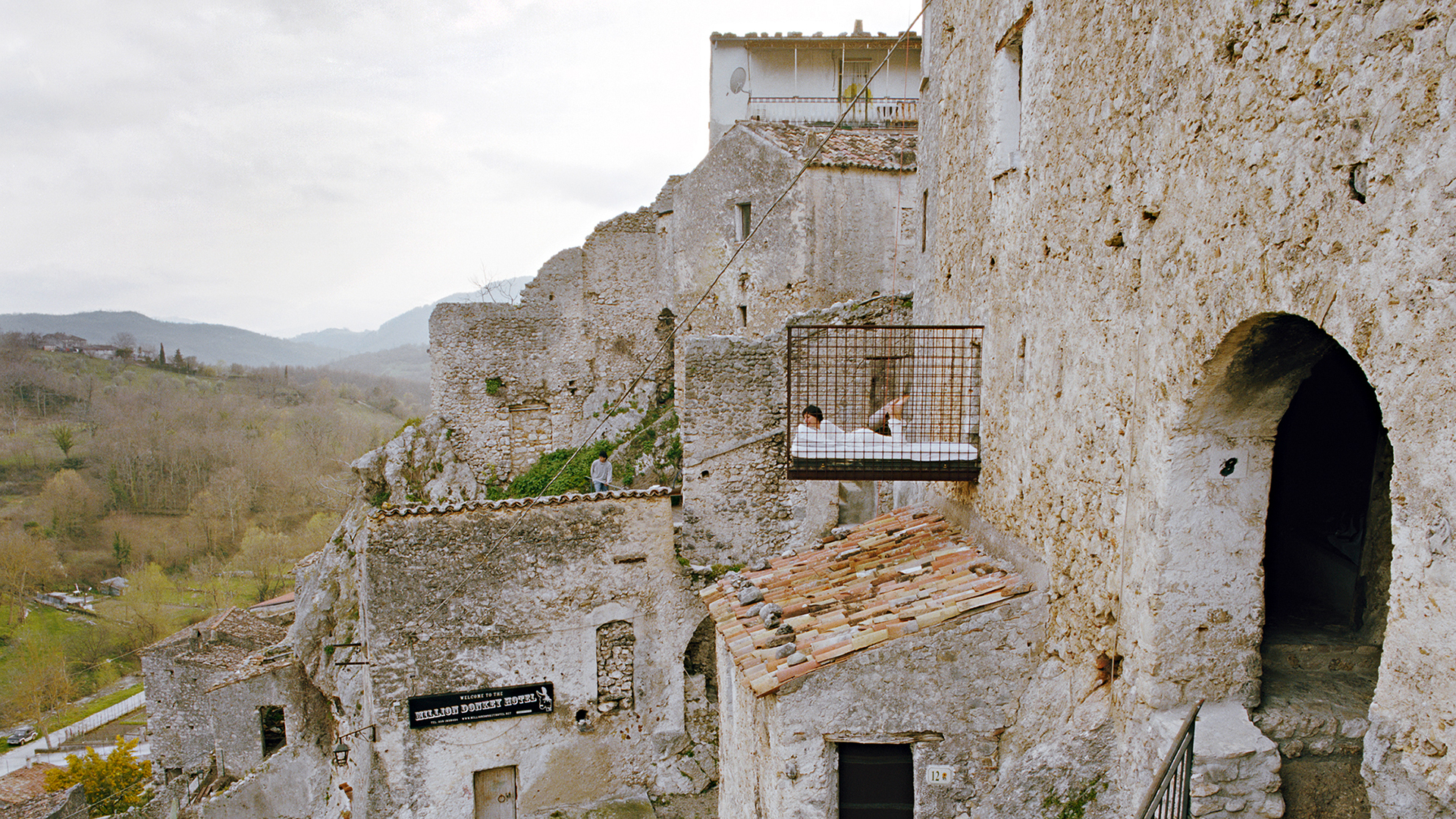Million Donkey Hotel
Million Donkey Hotel
73 % of the population of Europe lives in cities, and this figure is growing. This percentage not only means the constant growth of (in-between) cities but also and above all the disappearance of the cultural and natural landscapes familiar to us. In a complexity that we possibly are not aware of. The future of these zones threatened with extinction is also Europe’s future. Migration and its consequences is also the theme of “The Million Donkey Hotel”, a project by feld72 in the context of the “Villaggio dell’Arte” from the “paesesaggio workgroup”. In August 2005 a group of national and international artists was invited to address questions of identity, territory, social space and landscape in the Matese regional park near Naples by means of art projects involving the participation of the local population. The artists were required to live locally for one month, work together with the local population and draw all materials used from the local villages to stimulate the micro economy of the region.
Prata Sannita is a village divided into two, consisting of a mediaeval “borgo”, known as the Prata Inferiore, which cascades down a hill from a castle, and a newer part, the Prata Superiore, which owes its structure above all to the victory of the motor car and other promises of modernism. In the course of the last century Prata Inferiore was dramatically affected by migration caused by poverty and is now only a small part of the village, inhabited by a minority made up largely of elderly people, and with a very large number of empty buildings, some of which are already in ruins. How could these two clearly separated areas of the village be linked again? How and for whom could be the qualities of the almost sculptural spatial landscape be experienced once again? How can spaces that stand for loss become a self-confident part of a new Prata Sannita? How can a “free of ” lead to a “free to”?
Prata Sannita is seen in its entirety as a large, scattered hotel that still has rooms available: the abandoned rooms. These are not regarded as bearers of memories but as potential for the future: They become cells in a larger entity and the entire area of Prata Sannita is perceived as a single action space. The first adaptation of 3 spatial units (and a special “bathroom”) to form “hotel rooms” distanced from everyday life, is a start to making the spaces usable once again – but this time for a nomad not driven by worries about a better future – the traveller. The rooms were alienated and given specific themes and atmospheres based on migration and memory. Through the intervention the local residents were to be stimulated to understand, in a second phase, the other abandoned rooms as further building blocks of this hyper-real hotel and to reactivate them accordingly. The Million Donkey Hotel at the same time became an extension of public space, as in the “off-season” the hotel rooms can also be used by the Pratesi. Through the impressive involvement of up to 40 volunteers in the village (an estimated 4300 hours on site) it was possible to implement the Million Donkey Hotel despite the very tight time framework (1 month with design practically on site), a low budget (10,000€) and the use of only the simplest means. Thanks to the great success feld72 were invited back the following year. The work in 2006 was focussed primarily on public space, for example a ruined house in the immediate proximity of the hotel rooms already made was converted into a literal “stair-house” (amphitheatre) – and an association was set up. The Million Donkey Hotel is now organised by a small group of “local heroes” who were involved in building it and looks forward to visitors either on site or at www.milliondonkeyhotel.net.
feld72
buildings: all of their work, irrespective of scale or means, investigates how the world is engaged and perceived through the lens of architecture. And there is an architectural lesson we can draw from this work, namely that the essence of architecture is nothing architectural.” Kari Jormakka in “Theory and design in the Fourth Machine Age. On the experimental projects by feld72“, in „feld72. Urbanism – for sale.“ (Ed. Lilli Hollein), Springer WienNewYork 2008
They have exhibited at the Biennale di Venezia in 2011 / 2010 / 2008 / 2004, the Hongkong / Shenzhen bi-city Biennale of Urbanism\Architecture in 2009, the Biennial of the Canaries in 2009, the 3rd Triennial for Contemporary Art Guangzhou in 2008, the 7th International Architecture Biennial São Paulo 2007, and at the International Architecture Biennale Rotterdam in 2003.
They have also won many awards such as the contractworld award 2010, the City of Vienna’s Award for Architecture in 2008, The Chicago Athenaeum International Architecture Award in 2007, the Karl Hofer Award, the Art award of the Berlin University of the Arts in 2003 and the National Award for Experimental Tendencies in Architecture in 2002.
In 2010 feld72 was selected by the Jury of the Iakov Chernikhov Award as one of the Top 10 architecture studios worldwide under the Age of 44.
www.feld72.at
(source: www.feld72.at)
Photo credits:
1-5. Million Donkey Hotel, Hertha Hurnaus
Million Donkey Hotel
- Authors: feld72
- Location: Prata Sannita / Italy
- Year: 2005
- Budget: 10.000€
- URL: http://www.milliondonkeyhotel.net

